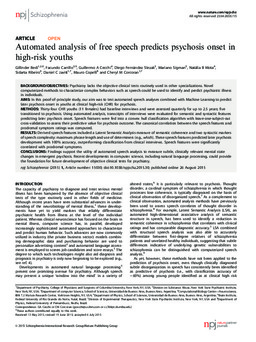Mostrar el registro sencillo del ítem
Automated analysis of free speech predicts psychosis onset in high-risk youths
| dc.rights.license | http://creativecommons.org/licenses/by/4.0/ | es_AR |
| dc.contributor.author | Bedi, Gillinder | es_AR |
| dc.contributor.author | Carrillo, Facundo | es_AR |
| dc.contributor.author | Cecchi, Guillermo A. | es_AR |
| dc.contributor.author | Fernández Slezak, Diego | es_AR |
| dc.contributor.author | Sigman, Mariano | es_AR |
| dc.contributor.author | Mota, Natália B. | es_AR |
| dc.contributor.author | Ribeiro, Sidarta | es_AR |
| dc.contributor.author | Javitt, Daniel C. | es_AR |
| dc.contributor.author | Copelli, Mauro | es_AR |
| dc.contributor.author | Corcoran, Cheryl M. | es_AR |
| dc.date.accessioned | 2018-08-06T14:08:33Z | |
| dc.date.available | 2018-08-06T14:08:33Z | |
| dc.date.issued | 2015-08-26 | |
| dc.identifier | doi: 10.1038/npjschz.2015.30 | es_AR |
| dc.identifier.uri | https://doi.org/10.1038/npjschz.2015.30 | es_AR |
| dc.identifier.uri | https://repositorio.utdt.edu/handle/20.500.13098/11075 | |
| dc.description.abstract | BACKGROUND/OBJECTIVES: Psychiatry lacks the objective clinical tests routinely used in other specializations. Novel computerized methods to characterize complex behaviors such as speech could be used to identify and predict psychiatric illness in individuals. AIMS: In this proof-of-principle study, our aim was to test automated speech analyses combined with Machine Learning to predict later psychosis onset in youths at clinical high-risk (CHR) for psychosis. METHODS: Thirty-four CHR youths (11 females) had baseline interviews and were assessed quarterly for up to 2.5 years; five transitioned to psychosis. Using automated analysis, transcripts of interviews were evaluated for semantic and syntactic features predicting later psychosis onset. Speech features were fed into a convex hull classification algorithm with leave-one-subject-out cross-validation to assess their predictive value for psychosis outcome. The canonical correlation between the speech features and prodromal symptom ratings was computed. RESULTS: Derived speech features included a Latent Semantic Analysis measure of semantic coherence and two syntactic markers of speech complexity: maximum phrase length and use of determiners (e.g., which). These speech features predicted later psychosis development with 100% accuracy, outperforming classification from clinical interviews. Speech features were significantly correlated with prodromal symptoms. CONCLUSIONS: Findings support the utility of automated speech analysis to measure subtle, clinically relevant mental state changes in emergent psychosis. Recent developments in computer science, including natural language processing, could provide the foundation for future development of objective clinical tests for psychiatry. | es_AR |
| dc.format.extent | 7 p. | es_AR |
| dc.format.medium | application/pdf | es_AR |
| dc.language | eng | es_AR |
| dc.relation.ispartof | npj Schizophrenia volume 1, Article number: 15030 (2015). ISSN: 2334-265X/15 | es_AR |
| dc.rights | info:eu-repo/semantics/openAccess | es_AR |
| dc.subject | Neurología | es_AR |
| dc.subject | Esquizofrenia | es_AR |
| dc.subject | Comunicación | es_AR |
| dc.subject | Habla | es_AR |
| dc.title | Automated analysis of free speech predicts psychosis onset in high-risk youths | es_AR |
| dc.type | info:eu-repo/semantics/article | es_AR |
| dc.subject.keyword | Neuroscience | es_AR |
| dc.subject.keyword | Schizophrenia | es_AR |
| dc.type.version | info:eu-repo/semantics/publishedVersion | es_AR |
| dc.description.filiation | Fil: Bedi, Gillinder. Department of Psychiatry, College of Physicians and Surgeons of Columbia University, New York, NY, USA. Division on Substance Abuse, New York State Psychiatric Institute, New York, NY, USA | es_AR |
| dc.description.filiation | Fil: Carrillo, Facundo. Department of computer Science, School of Sciences, Universidad de Buenos Aires, Buenos Aires, Argentina | es_AR |
| dc.description.filiation | Fil: Cecchi, Guillermo A. 4Computational Biology Center—Neuroscience, IBM T.J. Watson Research Center, Yorktown Heights, NY, USA | es_AR |
| dc.description.filiation | Fil: Fernández Slezak, Diego. Department of computer Science, School of Sciences, Universidad de Buenos Aires, Buenos Aires, Argentina | es_AR |
| dc.description.filiation | Fil: Sigman, Mariano. Universidad Torcuato Di Tella, Escuela de Negocios, Laboratorio de Neurociencia, Buenos Aires, Argentina. Consejo Nacional de Investigaciones Científicas y Técnicas (CONICET), Ministry of Science, Buenos Aires, Argentina | es_AR |
| dc.description.filiation | Fil: Mota, Natália B. 6Brain Institute, Federal University of Rio Grande do Norte, Natal, Brazil | es_AR |
| dc.description.filiation | Fil: Ribeiro, Sidarta. Brain Institute, Federal University of Rio Grande do Norte, Natal, Brazil | es_AR |
| dc.description.filiation | Fil: Javitt, Daniel C. Department of Psychiatry, College of Physicians and Surgeons of Columbia University, New York, NY, USA. Division of Experimental Therapeutics, New York State Psychiatric Institute, New York, NY, USA | es_AR |
| dc.description.filiation | Fil: Copelli, Mauro. Department of Physics, Federal University of Pernambuco, Recife, Brazil | es_AR |
| dc.description.filiation | Fil: Corcoran, Cheryl M. 1Department of Psychiatry, College of Physicians and Surgeons of Columbia University, New York, NY, USA. 7Division of Experimental Therapeutics, New York State Psychiatric Institute, New York, NY, USA | es_AR |

